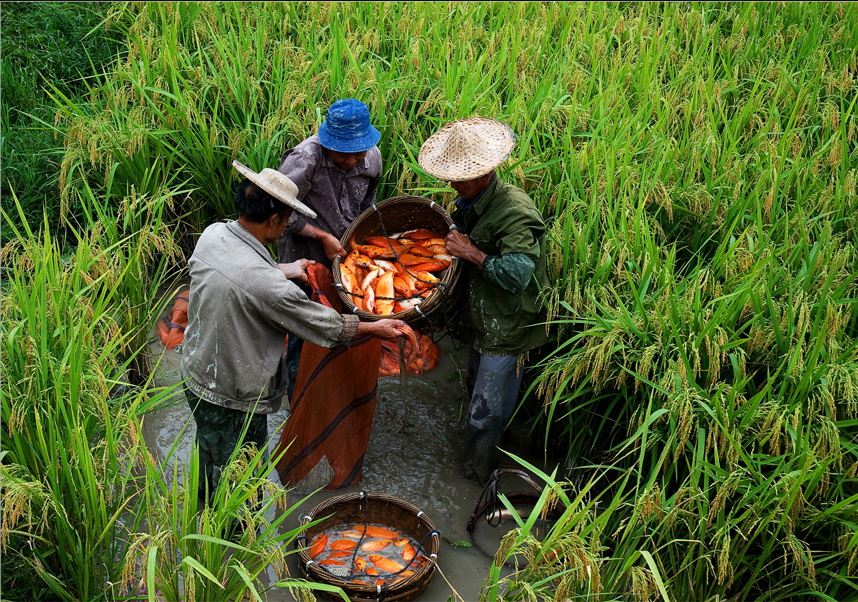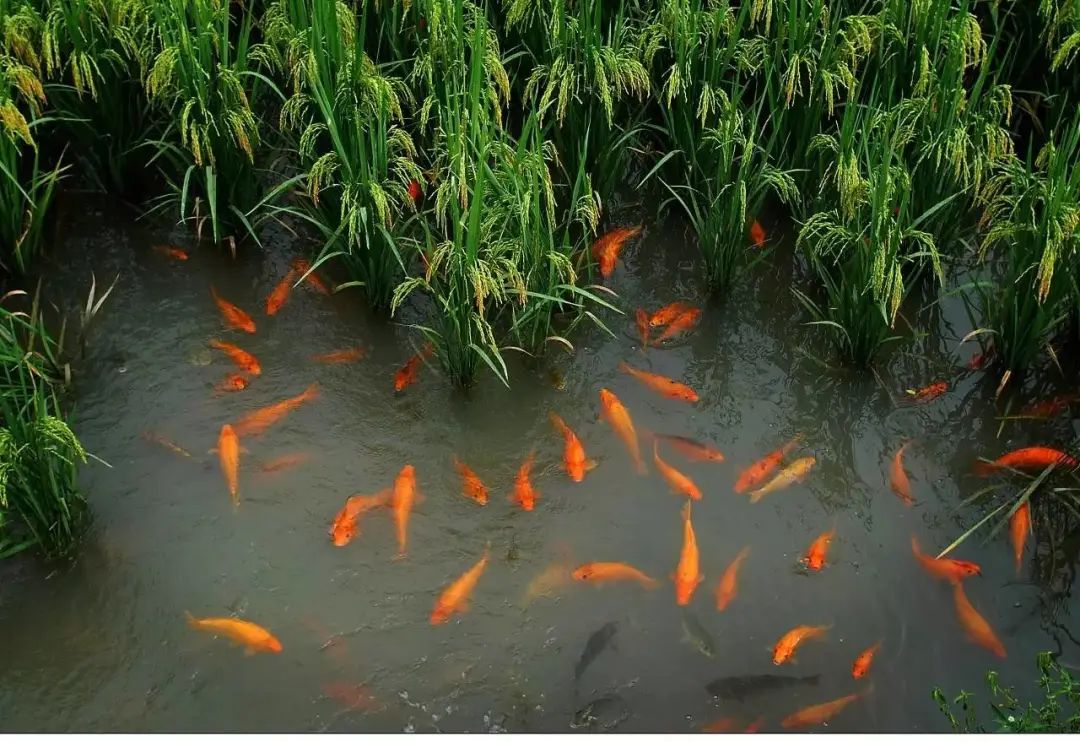China Greets the World with Rice-Fish Symbiosis
On December 13, 2022, the ecological restoration project of rice and fish comprehensive farming in Qingtian County, Lishui City, Zhejiang Province, as a typical case of Chinese landscape engineering, was displayed at the 15th Conference of the Parties (COP15) of the United Nations Convention on Biological Diversity, and presented to the world The people have demonstrated a beautiful China where man and nature live in harmony.
On August 15, 2023, China's first National Ecological Day, Qingtian rice-fish symbiosis, as my country's first globally important agricultural heritage, will show the beauty of China's ecology to the world and say hello to the world!

Pictures from Qingtian Media Group, CCTV
The Origin of Rice-fish symbiosis
In the Tang Dynasty, Liu Xun's "Ling Biao Lu Yi" also recorded: "Xinlong and other states, the mountains and fields are barren, and the flat places are opened with hoes and shovels, and they are opened as towns. They wait for the spring rain and store water in the hills. There are more fish (grass carp) seeds scattered in the paddy field. After one or two years, the fish will grow up and eat the grass roots. It will be a ripe field and attract fish. It is the best way to cultivate rice fields and kill barnyard grass. "Although there are differences between ancient and modern fish farming in rice fields, they all use grass carp to devour weeds in barren fields to open up wasteland. Although rice has not been planted in open barren fields, it is another form of fish farming in rice fields.
Qingtian rice fields have a long history of fish farming. As early as 1300 years ago, the ancestors used rice and carp to breed fish species with local characteristics, commonly known as field fish, and created the rice-fish symbiotic breeding technology.
This traditional agricultural symbiosis model is based on natural solutions. Fertile fields and rice reduce pests and diseases; Yuyue and field fish obtain sufficient food sources. Rice protects fish and fish promotes rice. In 2005, the Qingtian rice-fish symbiotic system was listed by the Food and Agriculture Organization of the United Nations as the first batch of Globally Important Agricultural Heritage (GIAHS) protection, and it is my country's first globally important agricultural heritage.

Pictures from Qingtian Media Group, CCTV
Inherit ancient farming wisdom
Fish farming in rice fields in Qingtian is a typical agricultural symbiosis model. Rice-fish symbiosis organically combines rice planting and fish farming, and plays a symbiotic and mutually beneficial role between rice and fish, resulting in a double harvest of rice and fish.
Rice-fish symbiotic rice provides suitable ecological environment and some bait for field fish, which can reduce the input of feed and the occurrence of fish diseases; field fish eat weeds and some pests in rice fields, which can control the occurrence of diseases, insect pests and weeds in rice fields and reduce pesticides Application; fish excretion can fertilize the field, fish swim back and forth in the paddy field, turn the soil, play a role in loosening the soil, promote the decomposition of fertilizer, which is beneficial to the development of rice tiller and root system, and can reduce fertilizer application. This model realizes the "dual control of fertilizer and medicine", and the nitrogen and phosphorus in the water discharged from the farmland have been greatly reduced. The double control of fertilizer and medicine has first reached the EU standard, providing a sample of Qingtian for the protection and restoration of agricultural ecology in mountainous areas of my country.
In 2012, China took the lead in the world to carry out the excavation of national agricultural heritage, and has now identified 91 items of China's important agricultural heritage; in 2014, the Chinese government and the Food and Agriculture Organization of the United Nations signed a South-South cooperation framework to carry out the work of globally important agricultural heritage Cooperation agreement; in 2015, China promulgated the world's first "Important Agricultural Heritage Management Measures"; in 2016, agricultural heritage work has been included in the Central No. 1 Document for three consecutive years.

Pictures from Qingtian Media Group, CCTV
Rice-fish symbiosis goes to the world
According to the United Nations Food and Agriculture Organization's pipeline network, the rice-fish symbiosis system is "a production model that combines planting and aquaculture. It is also a resource utilization system that not only greatly reduces the dependence on chemical fertilizers and pesticides, but also increases The biodiversity of the system ensures the ecological balance of the farmland, raises fish with rice, promotes rice with fish, and achieves mutual benefits in ecology, achieving a double harvest of rice and fish."
In addition, the rice-fish symbiotic system has also gone abroad, bringing hope to people in many countries around the world. In the 21st century, through South-South cooperation, Nigeria introduced the paddy-fish farming technology of "Zhejiang Qingtian Rice-Fish Symbiosis System". With the assistance of Chinese experts, the production of rice and tilapia in Nigeria has almost doubled, not only reducing poverty in rural areas, but also enabling local people to obtain high-quality food supplies. Today, the rice field symbiosis system has also been extended to many countries and regions in Southeast Asia, South Asia, Europe, America and Africa.
Qingtian County even seized the opportunity of the "Belt and Road" construction and launched a pilot reform of the national inspection of agricultural product export trade. Relying on more than 20,000 overseas Chinese restaurants, they serve rice, fish, rice and dried field fish on overseas tables. Yummy spreads the farming culture of the Chinese nation and shows Chinese culture to the world. Qingtian County insists on developing in protection and protecting in development. It not only initiated the establishment of the Globally Important Agricultural Heritage Conservation and Development Alliance, compiled two rounds of ten-year plans for the protection and development of the rice-fish symbiosis system, but also introduced the rice-fish symbiosis protection measures, and established A protection site for germplasm resources of field fish has been set up. At the same time, use innovation to lead inheritance and protection, seize the opportunity of digital reform in Zhejiang Province, establish a digital supervision system for the entire industry chain of "agricultural heritage protection" rice-fish symbiosis, and install monitoring equipment such as "one agricultural eye" to realize the precision of the rice-fish symbiosis environment Intelligent control brings new vitality to the millennium agricultural intangible cultural heritage.
Aquatic growth requires nitrogen, phosphorus, and potassium. Planting at a ratio of 10% to 15% of the water surface, the nitrogen and phosphorus nutrients in the aquaculture water body can fully meet the growth needs of rice. Rice can absorb nutrients such as nitrogen and phosphorus in the water body, which has a profound impact on the algae problem in the water body. If you want to use the fish-rice symbiosis model to solve the water quality pollution problem under the high-density farming model, you need to monitor the water quality in real time. By planting rice on the surface of the breeding water, it is possible to raise fish without changing the water, to plant rice without fertilization, and to harvest both fish and rice.
Chemins Technology is able to provide water quality monitoring services for rice-fish co-farming models, ensuring water quality while meeting the needs of aquaculture and rice farming. Dissolved oxygen sensor of Chemins technology can monitor the ammonia nitrogen content in water, widely used in water quality monitoring, sewage treatment and agricultural aquaculture industry, and can meet the water quality monitoring needs of rice-fish symbiosis system.
